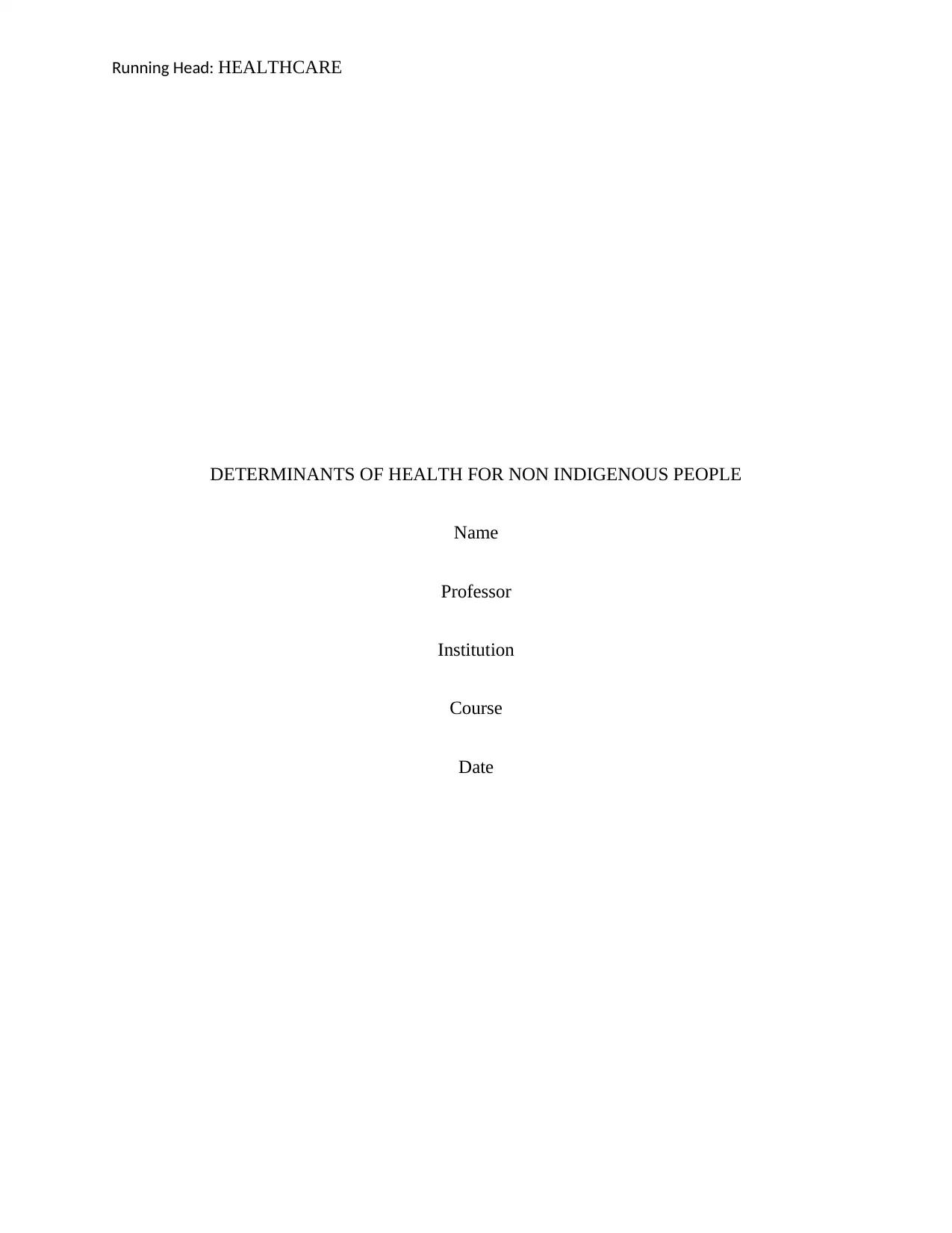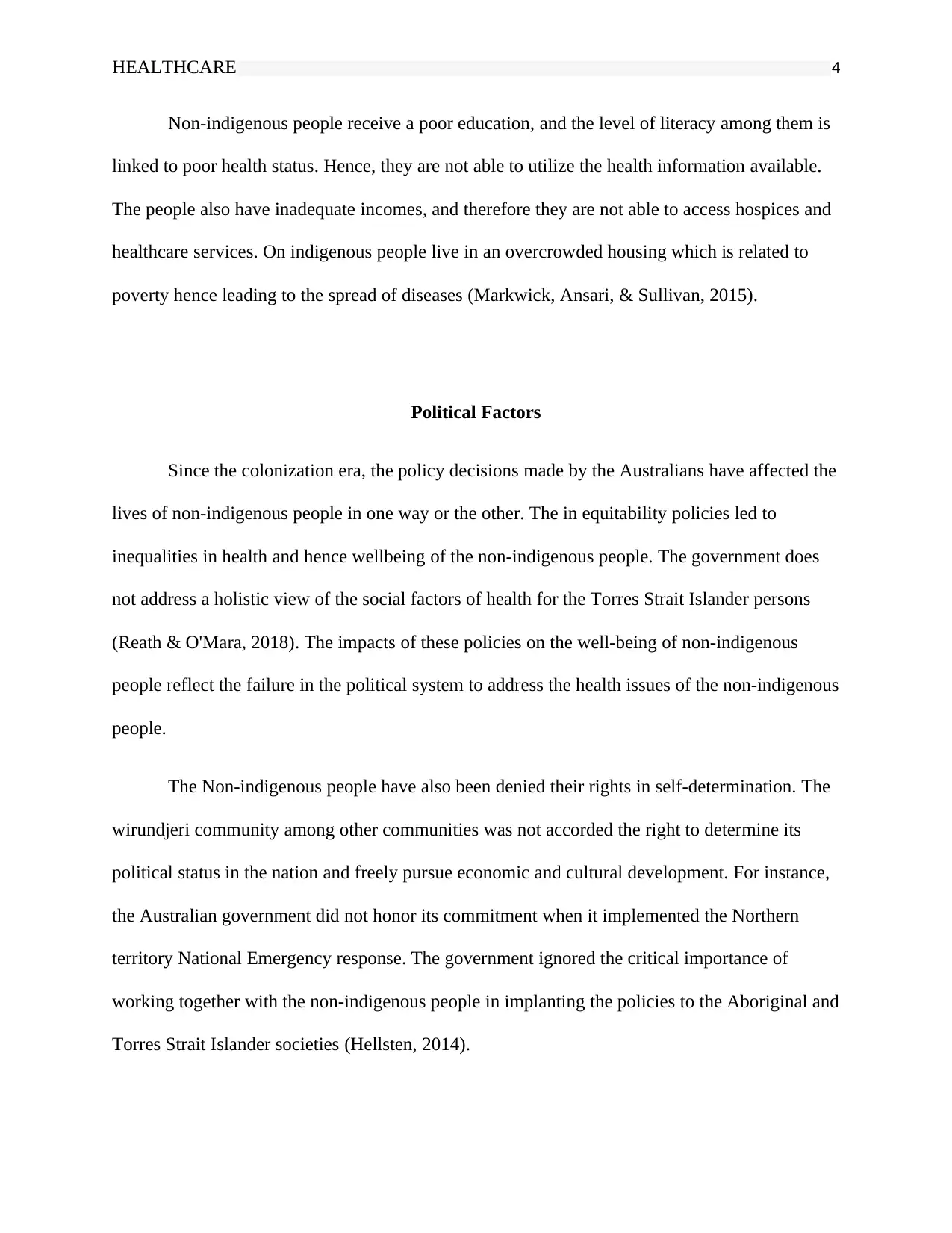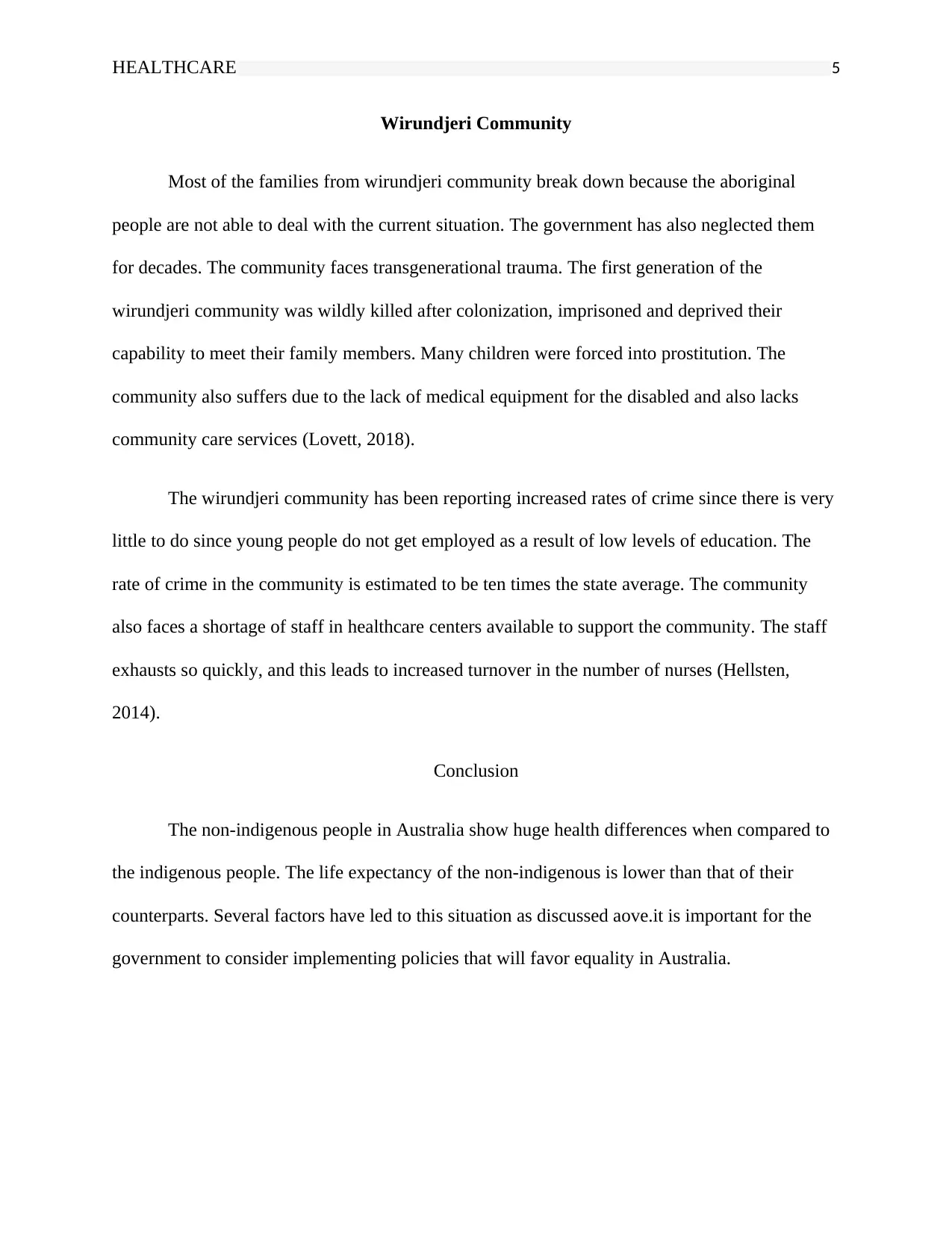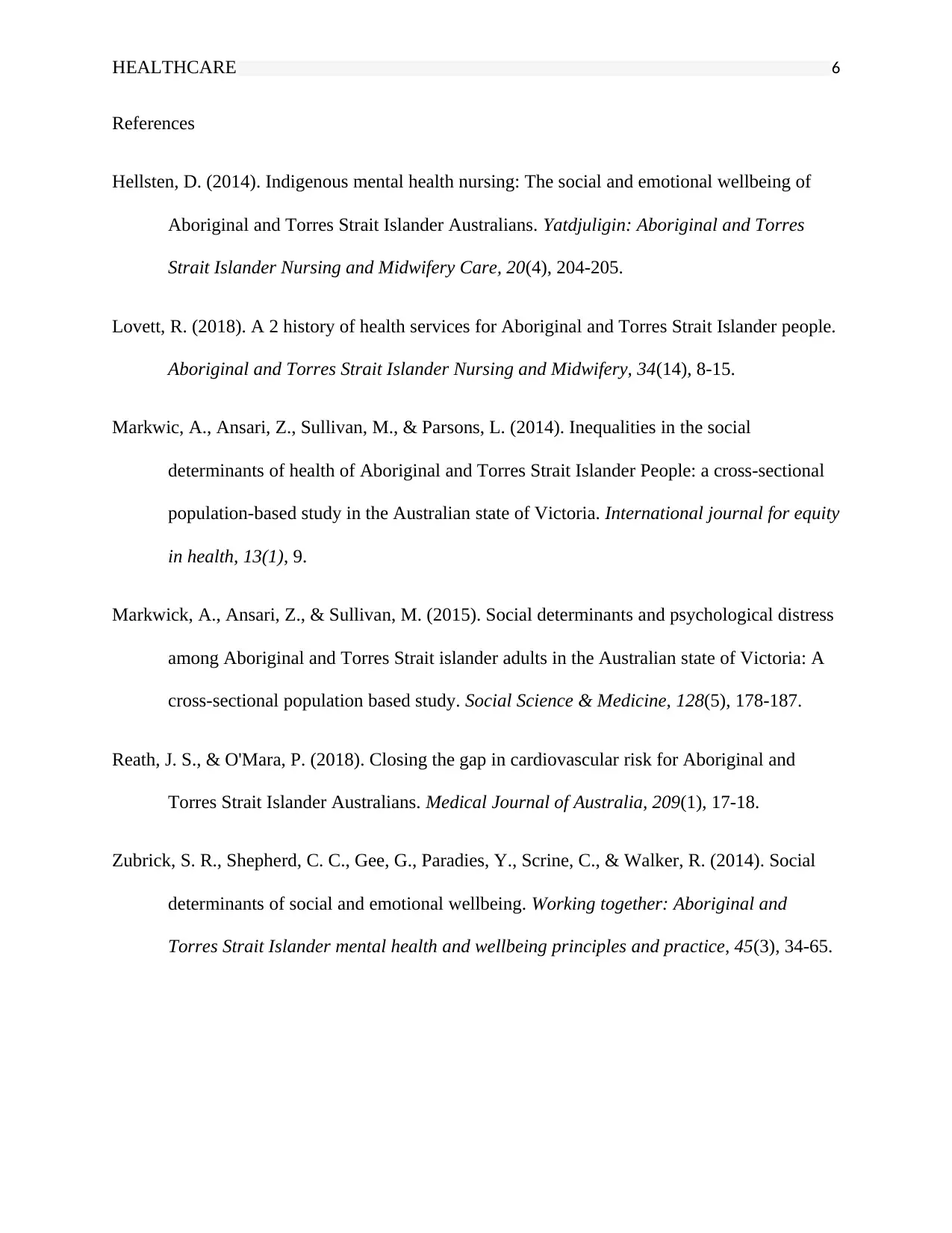Analysis of Healthcare Determinants for Non-Indigenous Australians
VerifiedAdded on 2022/08/23
|6
|1342
|18
Essay
AI Summary
This essay examines the health disparities between Indigenous and non-Indigenous people in Australia, focusing on the social, economic, and political determinants that contribute to these differences. It highlights how historical events, segregation, and discrimination have led to long-term physical and psychological impacts on Indigenous communities, like the Wirundjeri. The essay also discusses the economic disparities, such as high unemployment rates and low income levels, which result in risky health behaviors and limited access to healthcare for non-indigenous people. Furthermore, it addresses the impact of inequitable policies and the denial of self-determination rights, emphasizing the failure of the political system to adequately address the health issues of non-indigenous populations. The essay concludes by stressing the importance of implementing policies that promote equality and improve the health outcomes for all Australians. Desklib offers a wealth of resources for students, including similar essays and solved assignments.

Running Head: HEALTHCARE
DETERMINANTS OF HEALTH FOR NON INDIGENOUS PEOPLE
Name
Professor
Institution
Course
Date
DETERMINANTS OF HEALTH FOR NON INDIGENOUS PEOPLE
Name
Professor
Institution
Course
Date
Paraphrase This Document
Need a fresh take? Get an instant paraphrase of this document with our AI Paraphraser

HEALTHCARE 2
Introduction
Health disparities between the indigenous and non-indigenous people in Australia are
prevalent. Several factors have contributed to the health disparities between the Torres Strait
Islander people and the Aboriginals. There are several political, economic and social factors that
have led to the health disparities as discussed below.
The aboriginal Australians have a squatter life prospect and also poor well-being than the
non-indigenous people. Several factors lead to deteriorating health behavior among the
indigenous people that are not well understood. Conduct is triggered elements in the
instantaneous control of the individual. However, research designates that there are aspects
outside choice regulation that can affect the lives of indigenous people in Australia.
Social disruptions linked with historical events stimulate well-being hazardous manners.
Overconsumption of alcohol and tobacco smoldering has been associated with societal
disturbances. The anxiety allied to life may lead to the exercise of healthy risky behavior. Social
networks have also contributed to the deterioration of the health of indigenous people cultural
identity may be emotionally defensive and thus stimulate positive health conduct (Markwic,
Ansari, Sullivan, & Parsons, 2014).
Social Factors
Segregation and assimilation applied to the non-indigenous people and the indigenous
ones brought about institutionalism and geographical restrictions. Indigenous people like the
wirundjeri community were disallowed from speaking their ancient linguistic, practicing a
culture they had been practicing for long and schooling their youngsters their antiquity and
customs.
Introduction
Health disparities between the indigenous and non-indigenous people in Australia are
prevalent. Several factors have contributed to the health disparities between the Torres Strait
Islander people and the Aboriginals. There are several political, economic and social factors that
have led to the health disparities as discussed below.
The aboriginal Australians have a squatter life prospect and also poor well-being than the
non-indigenous people. Several factors lead to deteriorating health behavior among the
indigenous people that are not well understood. Conduct is triggered elements in the
instantaneous control of the individual. However, research designates that there are aspects
outside choice regulation that can affect the lives of indigenous people in Australia.
Social disruptions linked with historical events stimulate well-being hazardous manners.
Overconsumption of alcohol and tobacco smoldering has been associated with societal
disturbances. The anxiety allied to life may lead to the exercise of healthy risky behavior. Social
networks have also contributed to the deterioration of the health of indigenous people cultural
identity may be emotionally defensive and thus stimulate positive health conduct (Markwic,
Ansari, Sullivan, & Parsons, 2014).
Social Factors
Segregation and assimilation applied to the non-indigenous people and the indigenous
ones brought about institutionalism and geographical restrictions. Indigenous people like the
wirundjeri community were disallowed from speaking their ancient linguistic, practicing a
culture they had been practicing for long and schooling their youngsters their antiquity and
customs.

HEALTHCARE 3
Past carnages and discrimination formed long term bodily and physiological impacts on
the lives of indigenous persons that were trans-generational. Discrimination to the indigenous
people distresses their behavioral conduct. There was forced isolation of the children of the non-
indigenous people by the white settlers. The impacts of this isolation led the children of the non-
indigenous people being taken out of their families. This caused Transgenerational trauma to the
wirundjeri people hence affecting their social behavior.
The indigenous people in Australia face socio-economic shortcomings on almost every
primary sector. For instance, the rate of redundancy for the indigenous persons today is three
times higher than that of non-indigenous people. The augmented rate of unemployment among
the non-indigenous people contributes to risky healthy conduct among the non-indigenous
people (Zubrick, Shepherd, Gee, Paradies, Scrine, & Walker, 2014).
Economic factors
In Australia, there is a very high rate of unemployment among the non-indigenous
people. For instance, the rate of unemployment disparity among the indigenous folks in Australia
is 17% while that of the non-indigenous is 5% (Lovett, 2018). The daily stressors associated with
this economic disparity contribute to risky health behavior.
There is also increased rate of disparities in income between non indigenous people and
indigenous people. The low levels of income leads to poor health and hence non indigenous
people find it hard to pay hospitals bills when they fall sick.
Past carnages and discrimination formed long term bodily and physiological impacts on
the lives of indigenous persons that were trans-generational. Discrimination to the indigenous
people distresses their behavioral conduct. There was forced isolation of the children of the non-
indigenous people by the white settlers. The impacts of this isolation led the children of the non-
indigenous people being taken out of their families. This caused Transgenerational trauma to the
wirundjeri people hence affecting their social behavior.
The indigenous people in Australia face socio-economic shortcomings on almost every
primary sector. For instance, the rate of redundancy for the indigenous persons today is three
times higher than that of non-indigenous people. The augmented rate of unemployment among
the non-indigenous people contributes to risky healthy conduct among the non-indigenous
people (Zubrick, Shepherd, Gee, Paradies, Scrine, & Walker, 2014).
Economic factors
In Australia, there is a very high rate of unemployment among the non-indigenous
people. For instance, the rate of unemployment disparity among the indigenous folks in Australia
is 17% while that of the non-indigenous is 5% (Lovett, 2018). The daily stressors associated with
this economic disparity contribute to risky health behavior.
There is also increased rate of disparities in income between non indigenous people and
indigenous people. The low levels of income leads to poor health and hence non indigenous
people find it hard to pay hospitals bills when they fall sick.
⊘ This is a preview!⊘
Do you want full access?
Subscribe today to unlock all pages.

Trusted by 1+ million students worldwide

HEALTHCARE 4
Non-indigenous people receive a poor education, and the level of literacy among them is
linked to poor health status. Hence, they are not able to utilize the health information available.
The people also have inadequate incomes, and therefore they are not able to access hospices and
healthcare services. On indigenous people live in an overcrowded housing which is related to
poverty hence leading to the spread of diseases (Markwick, Ansari, & Sullivan, 2015).
Political Factors
Since the colonization era, the policy decisions made by the Australians have affected the
lives of non-indigenous people in one way or the other. The in equitability policies led to
inequalities in health and hence wellbeing of the non-indigenous people. The government does
not address a holistic view of the social factors of health for the Torres Strait Islander persons
(Reath & O'Mara, 2018). The impacts of these policies on the well-being of non-indigenous
people reflect the failure in the political system to address the health issues of the non-indigenous
people.
The Non-indigenous people have also been denied their rights in self-determination. The
wirundjeri community among other communities was not accorded the right to determine its
political status in the nation and freely pursue economic and cultural development. For instance,
the Australian government did not honor its commitment when it implemented the Northern
territory National Emergency response. The government ignored the critical importance of
working together with the non-indigenous people in implanting the policies to the Aboriginal and
Torres Strait Islander societies (Hellsten, 2014).
Non-indigenous people receive a poor education, and the level of literacy among them is
linked to poor health status. Hence, they are not able to utilize the health information available.
The people also have inadequate incomes, and therefore they are not able to access hospices and
healthcare services. On indigenous people live in an overcrowded housing which is related to
poverty hence leading to the spread of diseases (Markwick, Ansari, & Sullivan, 2015).
Political Factors
Since the colonization era, the policy decisions made by the Australians have affected the
lives of non-indigenous people in one way or the other. The in equitability policies led to
inequalities in health and hence wellbeing of the non-indigenous people. The government does
not address a holistic view of the social factors of health for the Torres Strait Islander persons
(Reath & O'Mara, 2018). The impacts of these policies on the well-being of non-indigenous
people reflect the failure in the political system to address the health issues of the non-indigenous
people.
The Non-indigenous people have also been denied their rights in self-determination. The
wirundjeri community among other communities was not accorded the right to determine its
political status in the nation and freely pursue economic and cultural development. For instance,
the Australian government did not honor its commitment when it implemented the Northern
territory National Emergency response. The government ignored the critical importance of
working together with the non-indigenous people in implanting the policies to the Aboriginal and
Torres Strait Islander societies (Hellsten, 2014).
Paraphrase This Document
Need a fresh take? Get an instant paraphrase of this document with our AI Paraphraser

HEALTHCARE 5
Wirundjeri Community
Most of the families from wirundjeri community break down because the aboriginal
people are not able to deal with the current situation. The government has also neglected them
for decades. The community faces transgenerational trauma. The first generation of the
wirundjeri community was wildly killed after colonization, imprisoned and deprived their
capability to meet their family members. Many children were forced into prostitution. The
community also suffers due to the lack of medical equipment for the disabled and also lacks
community care services (Lovett, 2018).
The wirundjeri community has been reporting increased rates of crime since there is very
little to do since young people do not get employed as a result of low levels of education. The
rate of crime in the community is estimated to be ten times the state average. The community
also faces a shortage of staff in healthcare centers available to support the community. The staff
exhausts so quickly, and this leads to increased turnover in the number of nurses (Hellsten,
2014).
Conclusion
The non-indigenous people in Australia show huge health differences when compared to
the indigenous people. The life expectancy of the non-indigenous is lower than that of their
counterparts. Several factors have led to this situation as discussed aove.it is important for the
government to consider implementing policies that will favor equality in Australia.
Wirundjeri Community
Most of the families from wirundjeri community break down because the aboriginal
people are not able to deal with the current situation. The government has also neglected them
for decades. The community faces transgenerational trauma. The first generation of the
wirundjeri community was wildly killed after colonization, imprisoned and deprived their
capability to meet their family members. Many children were forced into prostitution. The
community also suffers due to the lack of medical equipment for the disabled and also lacks
community care services (Lovett, 2018).
The wirundjeri community has been reporting increased rates of crime since there is very
little to do since young people do not get employed as a result of low levels of education. The
rate of crime in the community is estimated to be ten times the state average. The community
also faces a shortage of staff in healthcare centers available to support the community. The staff
exhausts so quickly, and this leads to increased turnover in the number of nurses (Hellsten,
2014).
Conclusion
The non-indigenous people in Australia show huge health differences when compared to
the indigenous people. The life expectancy of the non-indigenous is lower than that of their
counterparts. Several factors have led to this situation as discussed aove.it is important for the
government to consider implementing policies that will favor equality in Australia.

HEALTHCARE 6
References
Hellsten, D. (2014). Indigenous mental health nursing: The social and emotional wellbeing of
Aboriginal and Torres Strait Islander Australians. Yatdjuligin: Aboriginal and Torres
Strait Islander Nursing and Midwifery Care, 20(4), 204-205.
Lovett, R. (2018). A 2 history of health services for Aboriginal and Torres Strait Islander people.
Aboriginal and Torres Strait Islander Nursing and Midwifery, 34(14), 8-15.
Markwic, A., Ansari, Z., Sullivan, M., & Parsons, L. (2014). Inequalities in the social
determinants of health of Aboriginal and Torres Strait Islander People: a cross-sectional
population-based study in the Australian state of Victoria. International journal for equity
in health, 13(1), 9.
Markwick, A., Ansari, Z., & Sullivan, M. (2015). Social determinants and psychological distress
among Aboriginal and Torres Strait islander adults in the Australian state of Victoria: A
cross-sectional population based study. Social Science & Medicine, 128(5), 178-187.
Reath, J. S., & O'Mara, P. (2018). Closing the gap in cardiovascular risk for Aboriginal and
Torres Strait Islander Australians. Medical Journal of Australia, 209(1), 17-18.
Zubrick, S. R., Shepherd, C. C., Gee, G., Paradies, Y., Scrine, C., & Walker, R. (2014). Social
determinants of social and emotional wellbeing. Working together: Aboriginal and
Torres Strait Islander mental health and wellbeing principles and practice, 45(3), 34-65.
References
Hellsten, D. (2014). Indigenous mental health nursing: The social and emotional wellbeing of
Aboriginal and Torres Strait Islander Australians. Yatdjuligin: Aboriginal and Torres
Strait Islander Nursing and Midwifery Care, 20(4), 204-205.
Lovett, R. (2018). A 2 history of health services for Aboriginal and Torres Strait Islander people.
Aboriginal and Torres Strait Islander Nursing and Midwifery, 34(14), 8-15.
Markwic, A., Ansari, Z., Sullivan, M., & Parsons, L. (2014). Inequalities in the social
determinants of health of Aboriginal and Torres Strait Islander People: a cross-sectional
population-based study in the Australian state of Victoria. International journal for equity
in health, 13(1), 9.
Markwick, A., Ansari, Z., & Sullivan, M. (2015). Social determinants and psychological distress
among Aboriginal and Torres Strait islander adults in the Australian state of Victoria: A
cross-sectional population based study. Social Science & Medicine, 128(5), 178-187.
Reath, J. S., & O'Mara, P. (2018). Closing the gap in cardiovascular risk for Aboriginal and
Torres Strait Islander Australians. Medical Journal of Australia, 209(1), 17-18.
Zubrick, S. R., Shepherd, C. C., Gee, G., Paradies, Y., Scrine, C., & Walker, R. (2014). Social
determinants of social and emotional wellbeing. Working together: Aboriginal and
Torres Strait Islander mental health and wellbeing principles and practice, 45(3), 34-65.
⊘ This is a preview!⊘
Do you want full access?
Subscribe today to unlock all pages.

Trusted by 1+ million students worldwide
1 out of 6
Related Documents
Your All-in-One AI-Powered Toolkit for Academic Success.
+13062052269
info@desklib.com
Available 24*7 on WhatsApp / Email
![[object Object]](/_next/static/media/star-bottom.7253800d.svg)
Unlock your academic potential
Copyright © 2020–2025 A2Z Services. All Rights Reserved. Developed and managed by ZUCOL.





